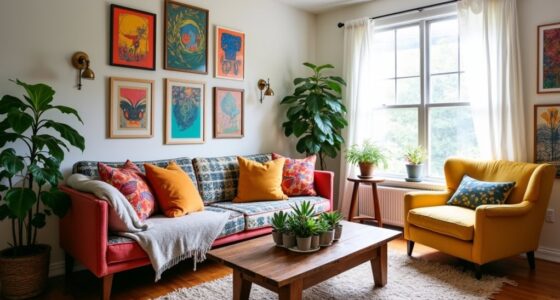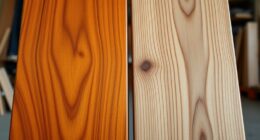To make your rooms feel luxe through textural contrast, combine soft, plush fabrics like velvet cushions with sleek, hard surfaces such as marble or polished wood. Mix matte finishes with shiny accents for depth, and layer different materials like linen, rattan, and textured metal to add visual interest. Balancing these textures, along with thoughtful use of finishes, creates a sophisticated and inviting space. Keep exploring to discover more tips for perfecting your interior texture blend.
Key Takeaways
- Combine soft, plush fabrics like velvet with sleek, hard surfaces such as marble or polished wood for luxurious contrast.
- Use layered textures, including matte, glossy, and tactile finishes, to add depth and visual interest.
- Incorporate metallic accents and reflective surfaces to enhance tactile richness and create a sense of opulence.
- Balance bold textures with softer elements to prevent overwhelming the space, maintaining harmony.
- Maintain a cohesive color palette, like monochrome or complementary shades, to unify diverse textures and elevate luxury.
Understanding the Power of Textural Contrast in Interior Design
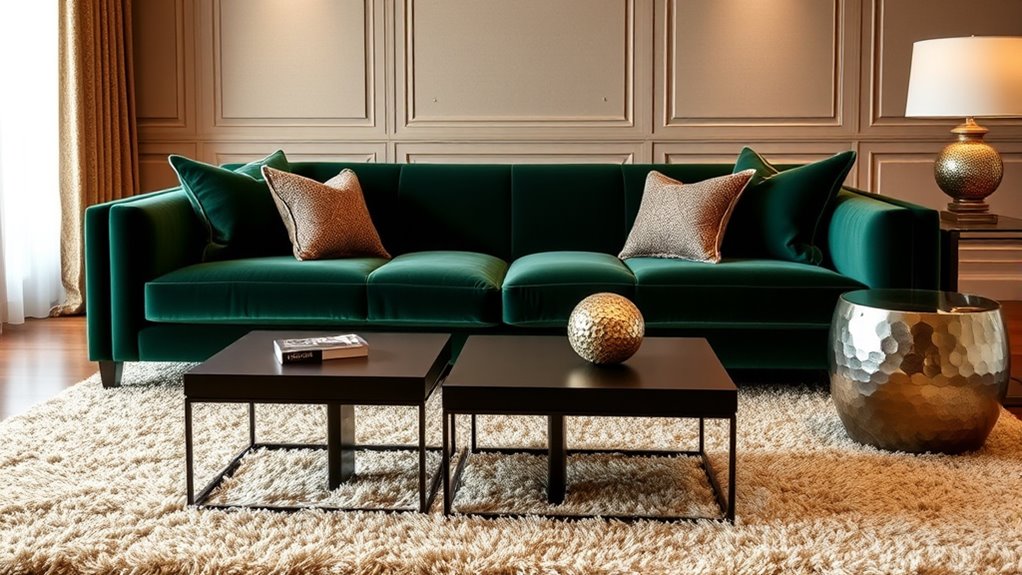
Have you ever noticed how a mix of different textures can transform a room from ordinary to extraordinary? Using monochrome palettes amplifies this effect, creating a sleek, unified look. When you incorporate color blocking—pairing bold, contrasting shades within the same hue—you add depth without overwhelming the space. Textural contrast plays a vital role here; combining smooth surfaces with rough or tactile finishes enhances visual interest and invites touch. For example, pairing matte walls with glossy accents or soft textiles with hard surfaces creates a dynamic environment. This technique emphasizes your design’s sophistication, making the room feel intentional and curated. By mastering the balance of textures within a monochrome palette and leveraging color blocking, you can craft a space that feels both modern and luxurious.
Selecting Complementary Textures for a Luxurious Look

To create a luxurious look, start by layering different fabric types to add depth and interest. Mix matte finishes with shiny surfaces to enhance visual contrast, and combine soft textiles with textured elements for a rich, inviting feel. These choices work together to craft a balanced, sophisticated space that exudes elegance. Incorporating self-watering plant pots can also introduce a sleek, modern element that blends functionality with style, further elevating your room’s luxurious appeal.
Layer Different Fabric Types
Layering different fabric types can instantly elevate your space by adding depth and visual interest. Start by gathering fabric swatches to compare textures and textile patterns. Mix smooth, sleek materials like silk or satin with plush, nubby fabrics such as velvet or boucle. This contrast creates a rich, layered look that feels luxurious. Use a variety of textile patterns—think subtle jacquards, bold weaves, or intricate embroidery—to add complexity without overwhelming the space. Be mindful of color coordination to ensure harmony. Combining different fabric types not only enhances tactile appeal but also introduces a sophisticated dimension that invites touch and visual intrigue. Consider the importance of asset division in interior design to balance and allocate visual weight effectively. With thoughtful selection, your room will exude a curated, high-end aesthetic full of inviting textures.
Mix Matte and Shine
Mixing matte and shiny finishes is a powerful way to create a sophisticated, eye-catching space. This combination adds textural harmony, balancing smooth, reflective surfaces with softer, muted ones. By pairing matte walls with glossy accents or fixtures, you introduce visual diversity that keeps your room engaging without overwhelming. The contrast heightens the perception of depth and richness, making every element stand out. To achieve a cohesive look, select finishes that complement each other’s tones—think warm matte neutrals with sleek metallics, or cool greys paired with polished surfaces. This interplay of textures creates a layered, luxe atmosphere that feels both dynamic and refined. Remember, the key is to strike a balance, allowing each finish to enhance the other for a truly elevated space. Incorporating texture contrast can also emphasize the quality and craftsmanship of your fine rug, elevating the overall aesthetic.
Combine Soft and Textured
Pairing soft, plush textures with more structured, textured surfaces creates a luxurious and inviting environment. To achieve this, consider furniture placement that balances comfort and sophistication—think a velvet sofa paired with textured accent pillows. Use lighting techniques to highlight these contrasts; soft, warm lighting enhances plush fabrics, while accent lights emphasize textured surfaces. Incorporate materials like a silky throw on a rougher wood side table or a plush rug over polished flooring. This combination adds depth and richness to your space, making it feel both cozy and refined. For a cohesive look, choose complementary textures that play off each other without clashing. Here’s a quick guide:
| Texture Type | Example | Placement Tip |
|---|---|---|
| Soft | Velvet | Sofa, cushions |
| Textured | Linen, Rattan | Accent walls, accessories |
| Plush | Faux fur | Throw blankets |
| Structured | Leather | Furniture frames |
| Mixed | Silk & Wood | Decor elements |
Additionally, understanding the material properties of each texture can help you select options that not only look good but also feel harmonious to the touch.
Incorporating Soft and Hard Surface Combinations

Combining soft and hard surfaces in a space creates a dynamic contrast that enhances visual interest and tactile appeal. To achieve textural harmony, carefully balance plush textiles with sleek, rigid materials. For example, pair a soft, upholstered sofa with a polished hardwood or stone flooring to introduce surface variation that draws the eye. Layering textures like velvet cushions or a shaggy rug alongside smooth surfaces adds depth without clutter. This interplay emphasizes the richness of your design, making the room feel curated and luxurious. Be intentional with placement: soften hard surfaces with textiles in seating areas, while hard surfaces can act as visual anchors. Understanding the variety of textures available can help you create a more nuanced and engaging space. By thoughtfully combining soft and hard elements, you create a space that feels both inviting and sophisticated.
Using Metallic and Matte Finishes to Add Depth
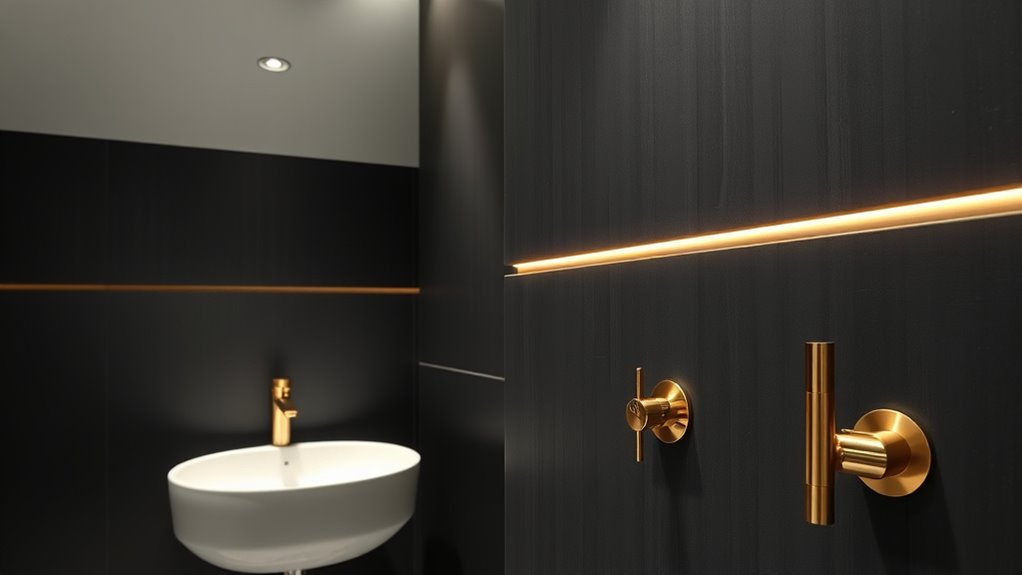
To add visual depth and sophistication to your space, incorporating metallic and matte finishes is a highly effective strategy. Metallic accents, like gold or chrome, catch the light and create a striking contrast against matte surfaces. This interplay enhances the room’s texture and adds a sense of luxury. Consider these options:
- A matte wall paired with shimmering metallic light fixtures
- Matte black furniture contrasted with metallic hardware
- A satin-finish coffee table with metallic legs
- Matte vases or sculptures accented with metallic detailing
- Incorporating rustic textures such as reclaimed wood or vintage-inspired accessories can further elevate the farmhouse charm while maintaining a luxurious feel.
Layering Textures for Visual and Tactile Richness

To create visual and tactile richness, start by mixing different fabrics and materials to add layers of interest. Vary surface finishes, such as gloss and matte, to enhance contrast and depth. Incorporate both soft and hard elements to engage the senses and bring your space to life. Consider incorporating antique pieces to add character and a sense of history, enriching the overall texture and visual appeal.
Mix Fabrics and Materials
Layering different fabrics and materials instantly adds depth and interest to your design. To achieve this, mix various textures like velvet, linen, leather, and wool. Focus on pattern mixing to create visual intrigue, combining subtle prints with bold designs. Guarantee color coordination by choosing hues that complement each other, such as warm earth tones or cool neutrals. This balance makes your space feel cohesive yet richly layered. Regularly assess and rotate items to prevent clutter buildup and maintain the curated look. Picture these combinations:
- A plush velvet sofa paired with sleek leather accent pillows
- Linen curtains contrasted with a patterned rug
- Wool throws layered over a smooth leather armchair
- Soft cotton bedding with textured throw pillows
These pairings help you craft a luxe ambiance that pleases both the eye and the touch.
Vary Surface Finishes
Building on your fabric and material choices, varying surface finishes introduces even more depth and tactile interest to your space. By selecting different wall treatments and flooring options, you create contrast that elevates the room’s luxe feel. Matte, glossy, and textured finishes add visual layers, while varied materials like polished wood, rough stone, or soft rugs enhance tactile richness. Combining smooth wall paints with textured wallpapers or wood paneling brings a sophisticated depth. Similarly, mixing plush carpets with sleek tiles or polished hardwood floors balances softness with hard surfaces. This deliberate layering adds complexity, making each surface a statement of elegance and comfort. Incorporating vintage decor elements can further enhance the textured appeal, adding charm and authenticity to your design.
Incorporate Soft and Hard Elements
Incorporating both soft and hard elements creates a dynamic interplay that enhances a room’s visual and tactile appeal. This textural contrast brings depth and interest to your space. To achieve this, consider layering these elements thoughtfully:
- A plush velvet sofa paired with sleek marble side tables adds softness and hardness.
- Textured wool rugs under smooth hardwood floors create tactile richness.
- Soft linen curtains contrast with hard, polished metal fixtures.
- Cushions and throws with varied textures break up solid surfaces and invite touch.
- Integrating high-contrast color fidelity in your decor can further amplify the visual depth created by textures.
Practical Tips for Achieving Balance and Cohesion
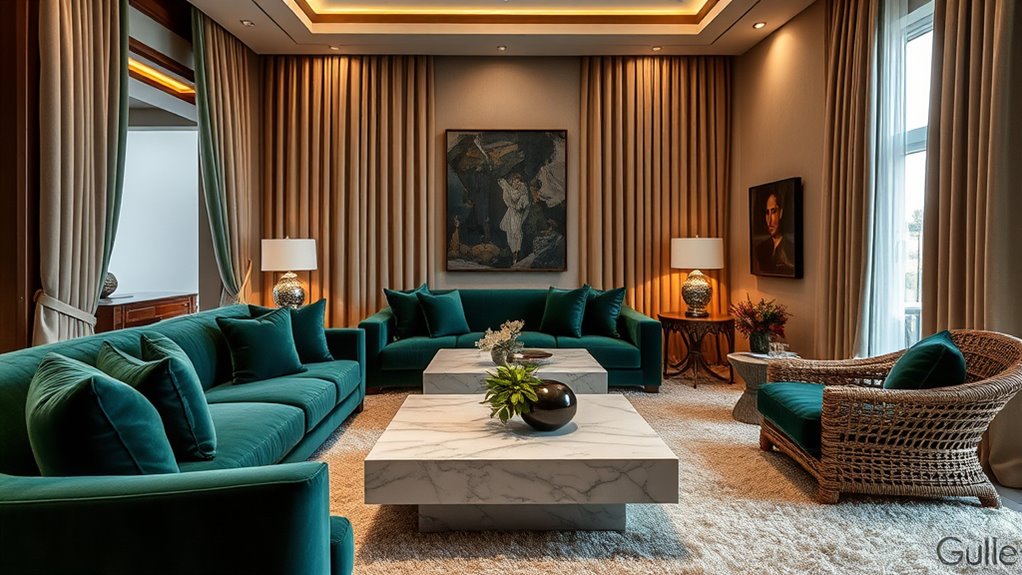
Achieving balance and cohesion in textural contrast requires deliberate choices that harmonize different surface qualities. Start by focusing on color harmony; select a neutral palette or complementary shades to unify contrasting textures. Use lighting techniques to highlight textures without overpowering them—layer ambient, task, and accent lighting to create depth and warmth. Consistent color schemes help tie diverse surfaces together, making the space feel cohesive despite varied textures. Avoid overwhelming the room by balancing bold textures with calmer, softer elements. Keep a visual rhythm by repeating similar finishes or tones across different surfaces. These strategies ensure your room feels intentional and luxurious, where textures enhance rather than clash, creating a harmonious and inviting environment.
Frequently Asked Questions
How Do I Choose Textures That Match My Personal Style?
When selecting textures that match your personal style, start by considering your favorite fabric patterns and how they reflect your taste. Mix different material contrasts—like plush velvet with sleek leather or soft linen with textured wool—to create visual interest. Trust your instincts and choose textures that make you feel comfortable and confident. Combining these elements thoughtfully can make your space uniquely yours, adding both style and personality effortlessly.
Can Textured Accents Work in Small Spaces?
Think of textured accents as the jewelry of your small space—they add sparkle without overwhelming. Yes, they work beautifully! Incorporate wall treatments like textured wallpaper or fabric accents on cushions and throws to create depth. These elements draw the eye and make the room feel more luxurious, even in tight quarters. Just choose subtle textures and strategic placement, and you’ll transform your small space into a cozy, stylish retreat.
What Are Common Mistakes to Avoid With Texture Mixing?
When mixing textures, you want to avoid pattern clashes and excessive layering, as they can make your space feel chaotic rather than cohesive. You might think more is better, but overdoing it can overwhelm the room. Instead, balance bold textures with subtle ones, and stick to a harmonious color palette. This way, your space feels inviting and luxurious without the risk of visual clutter or discord.
How Do Lighting Choices Affect Textured Surfaces?
Lighting can make or break the way textured surfaces shine. You’ll want to choose lighting ambiance that highlights surface reflections without washing out the details. Soft, warm lights create a cozy, inviting vibe, while brighter or directional lighting accentuates intricate textures, adding depth. When done right, your textured surfaces will glow, giving your room a luxe feel. Just remember, a little light goes a long way to emphasize those rich details.
Are There Seasonal Trends in Textural Design?
You might notice seasonal textures becoming more popular as people embrace cozy, tactile materials during colder months and lighter, smoother surfaces in warmer seasons. Seasonal textures reflect current trends that favor warmth and comfort in winter with plush fabrics, and airy, sleek designs in summer. Staying updated on textural trends helps you create spaces that feel fresh and appropriate year-round, aligning your decor with the changing seasons effortlessly.
Conclusion
So, next time you want your space to scream luxury, just remember: layering textures is your secret weapon—who knew that mixing soft and hard, matte and metallic could make a room feel so rich? It’s almost ironic how a little contrast can do so much, turning simple rooms into lavish retreats. So go ahead, experiment boldly. After all, in the world of luxe interiors, it’s the unexpected textures that truly make the statement.




